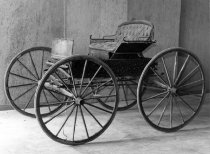Object Record
Images

Metadata
Title |
Buggy/Runabout, c. 1890 |
Object Name |
Buggy |
Description |
Buggy/Runabout, c. 1890. Buggy has a single black leather upholstered seat and iron tires. It would be drawn by a single horse. Removable black leather cover is affixed with iron side bars. This example had a folding leather top and was trimmed in black leather. As with many of the horse-drawn vehicles belonging to the Holbrook-Palmer family, it was made by Studebaker and has the maker’s tag on the rear spring block. The undercarriage color is difficult to determine (black or dark green) but traces of double line striping are evident on the wheels. Part of the San Mateo County Historical Association's carriage collection. |
Date |
c. 1890 |
Creator |
Studebaker Bros. Mfg. Co., Chicago |
Role |
Manufacturer |
Catalog Number |
1975.236.004 |
Dimensions |
H-62 W-81 D-108 inches |
Collection |
3D - Land Transportation Tools & Equipment |
Inscription Text |
"STUDEBAKER.BROS.MFG.CO / ..." (brass plaque) |
Provenance |
From the Holbrook-Palmer Collection of the Town of Atherton. |
Notes |
Through the standardization of parts and industrialized production, American carriage builders created light weight, four-wheeled vehicles to be pulled by a single horse. Because they were light, and less encumbering for the horse, they could also travel longer distances. These vehicles were called Buggies, Runabouts or Road Wagons. The names attached to them were at the discretion of the makers. Some were used for general transportation. Others used with fast trotting horses for informal "brushes" (races). Their lightness contributed to their speed. Other characteristics were near equirotal wheels. Bodies were generally thin panels of popular. Wheel felloes were hickory. Some had leather folding tops. The average Buggy or Road Wagon could be purchased in the late 19th century for around $20.00. However, a Trotting Wagon with side bar springs that was slightly lighter was sold by Brewster & Company for around $400.00. [Carriage Consultant Merri Ferrell, 8/2021] [http://www.britannica.com/EBchecked/topic/83761/buggy] buggy, also called road wagon, light, hooded (with a folding, or falling, top), two- or four-wheeled carriage of the 19th and early 20th centuries, usually pulled by one horse. In England, where the term seems to have originated late in the 18th century, the buggy held only one person and commonly had two wheels. By the mid-19th century the term had come to the United States and the buggy had become a four-wheeled carriage for two passengers. The shapes in which the vehicle was built varied widely. The coal-box buggy and, especially, the piano-box, or square-box, buggy enjoyed great popularity. Without a top a buggy was usually called a runabout, or a driving wagon, and if it had a standing top it was called a Jenny Lind. The buggy became the universal American vehicle, and by the 1870s its popularity, along with that of the road cart and the spring wagon, brought about the mass production of carriages in Cincinnati, Ohio, and other carriage-building centres. This led to price reductions that further stimulated the popularity of the buggy. It was the Model T Ford of its day, and it continued to be widely used for 10 or 15 years into the 20th century. This carriage currently in storage and not available for viewing. |
Search Terms |
Atherton Holbrook-Palmer Carriage Carriages |
Subjects |
Carriages & coaches Transportation |
People |
Holbrook-Palmer, Olive |
Credit line |
Courtesy of the Town of Atherton |
